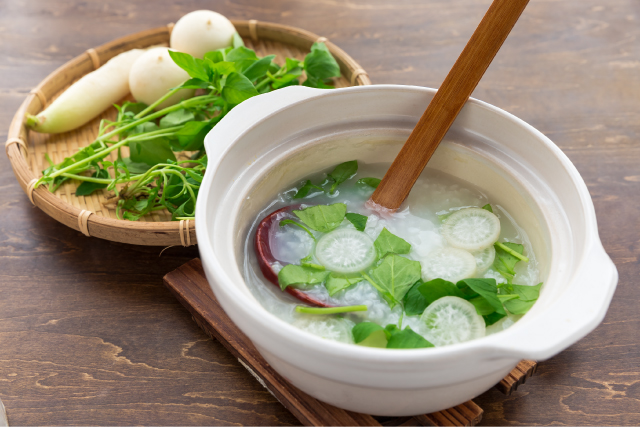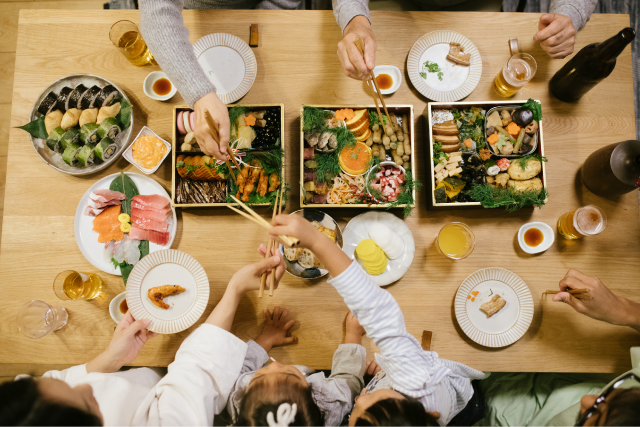Japanese traditions

-New Year’s Traditions-
It is the day of welcoming and celebrating the New Year, and offering a memorial service for your ancestors. An annual event that the Japanese value most in a year. It can be said to be the basis of Japanese life.
・New Year’s Eve
December 31 is called Omisoka.
It involves cleaning up, *1 preparing Osechi (New Year's food), *2 eating Toshikoshisoba (New Year's soba) with your family, *3 listening to Joyanokane at midnight, and wishing for a good start to the year.
・Hatsumode
Visit a religious temple by Matsunouchi (until January 7th). *4 This is a ritual to greet the Toshi-kamisama (zodiac) for 4 years
・Wakamizu
It's the first water you drink in the early morning of New Year's Day. Also called Hatsumizu. It is spent to prepare a meal for the New Year gods.
・Nenshi
Giving greetings to people and relatives who have supported you.
・Hatsuyume
Foretelling the fortune of the year with the content of your dreams seen on New Year's Day. *5 Ichi-Fuji, Ni-taka, San-nasubi" (First Fuji, second eagle, third eggplant) are said to be good dreams.
・Shigotohajime
Also known as Kotohajime. Working for the first time in the new year. It is generally adjusted to the government office's schedule.
・Nanakusa

On the morning of the 7th, eat the "seven herb soup" containing the spring herbs of "seri, nazuna, gogyo, hakobera, hotokenoza, suzuna, suzushiro".
・Kagamibiraki
On January 11, eat *6 Kagami-mochi as * 7 oshiruko (soup). Split this with a hammer. The reason is that cutting with a knife is considered bad luck and unpure.
※1Osechi: Ceremonious food for New Year’s

※2 Toshikoshisoba: Soba eaten on New Year’s eve. It includes the hope of living long with no sickness for the upcoming year.
※3 Joyanokane: Temple bells rung at midnight on New Year’s Eve
※4 Toshi-kamisama (zodiac): A god descending from high mountains in order to bring happy New Year’s to homes.
※5 Ichi-fuji ni-taka san-nasubi: Among the things that you can dream of in your first dream, this is a phrase that lists the things that are said to mean good luck.
※6 Kagamimochi: A rice cake that is made flat and round, and has double layers large and small. Offered to the gods and decorated during New Year's.
※7 Oshiruko: This is a food made by adding rice cake, white rice dumplings etc. to the soup of red beans sweetly boiled with sugar.
-Spring traditions-
・Setsubun
First day of spring. “Oniwa-soto, fukuwa-uchi” (demons outside, fortune inside) is chanted while throwing beans.
・Hinamatsuri

A hina doll is displayed to celebrate this festival of girls. March 3 is the most common date, but in snowy areas, it is sometimes held on April 3. Dolls are considered an amulet and a substitute for girls.
・Hanami
A custom to bask in the arrival of spring by viewing plum and cherry blossoms. Sakura blooms from March. The whole of Japan is bustling around May, when the sakuras head north and reach Nemuro in Hokkaido.
-Summer traditions-
・Tangono-setsuku
After ※8 hachijuhachiya passes, and May 5th rolls around signaling the beginning of spring, it is time for the boy's festival. It was incorporated from Chinese folk customs. May dolls and warrior decorations are displayed with the hope to help boys grow up healthy. Customs such as *9 koi-nobori that swim in the skies, *10 kashiwa mochi and *11 chimaki, * 12 shobu-yu, *13 and ken-sho also remain.
・Tanabata
A star festival derived from the legend that Hikoboshi (Altair) meets Orihime (Vega) in the Milky Way on the night of July 7. Tanabata was originally called "Kitsukouden."
・Chugen
It means the memorial service of the dead and the memorial service of the living spirits. It falls on what was the Day of Atonement of China. It is a day of celebrating that we were able to live in peace.
・Bon memorial service
It has a long history, and it is recorded that it was first held in the imperial palace on July 15th in 606. It is an event where Buddhist prayers and prayers for good harvest overlap. Bon-iri, Shinfutsu-kuyo, Bon-odori, and Okuri-bon are rituals that still remain.
・Natsumatsuri
It is a memorial service for ancestors and prayer for good harvest and to rid of bad energy. The fact that there are still religious rituals to this day is a remnant of this. The fact that women cannot carry u *14 is related to Shinto rituals.
※8 Hachijuhachiya:The 88thd day since the first day of spring. Around May 2. A period where farmers plant seeds.
※9 Koi-nobori: A Japanese custom in which families in the Edo Period would have streamers in the shape of a carp waving in the wind, to pray for their boys to grow healthily.
※10 Kashiwa mochi: It is a Japanese confectionery made by putting bean paste on a round rice cake, folding it in half and wrapping it in Kashiwa-no-ha. This "Kashiwa-no-ha" is a special leaf, and the characteristic is that old leaves fall only after new shoots emerge. It is said that this feature led to the ideas of "the family line never ends" and "the prosperity of the descendants" and it spread due to this sense of good fortune.
※11 Chimaki: Steamed rice cake wrapped with kaya and bamboo leaves.
※12 Shobu-yu: A bath in which the roots and leaves of irises are put and boiled.
※13 Ken-sho: Bundles of lotus and iris leaves are lowered from the roof of the eaves of houses. Lotus and irises are plants that remove evil. By lowering these from the eaves, they prevent bad energy from coming in from the outside.
-Autumn traditions-
・Tsukimi
Since ancient times in Manyo, people have been paying close attention to flowers, birds, the wind and moon, and appreciate the beauty of nature. Just as there are many famous spots for sakura, there are similar spots for the moon, such as Katsurahama in Kochi. From long ago to now, people view the mid-autumn moon, such as on the 15th and 13th night.
・Autumn equinox
Beginning on September 21, memorial services for the ancestors are held for 7 days.
・Aki matsuri
They are all tied to agricultural rituals. The Autumn Festival is said to be a village festival, but it is because good harvest and good catch of fish were considered congratulatory events on a village-wide scale.
・Koyo-gari
As we dive deeper into autumn and when frost begins to fall, deciduous trees in the mountains begin to color and autumn leaves start to show. It is said that the autumn scenery looks like brocade. There are many famous spots for autumn colors such as Nikko, Hakone, and Yabakei, and the autumn leaves front runs from north to south.
-Winter traditions-
・Shichi-go-san

A ceremony to celebrate the growth of children on November 15th. There are "Kamioki" (growing hair) for 3-year-old boys and girls, "Hakamagi" (wearing hakama for the first time) for 5-year-old boys, and "Obitoki" (wearing kimono for the first time) for 7-year-old girls.
・Seibo
A gift for the end of the year. It is said that Chinese events are the source of year-end gifts. It is the same as Chugen, in which food is mainly given to those who you are grateful for.
・Toji
It is one of the twenty-four divisions of the solar year and falls around December 22nd. There are customs for each region, such as eating pumpkin and bathing in yuzu-yu *14.
・Susuharai
From Edo to Taisho, people were doing a house-clean sweep on December 13th. From the Showa era, there is a history that the day of house-cleaning became optional.
※14 Yuzu-yu: A bath with a citron.
Conclusion
How was it?
There are many other traditions in Japan.
It may be fun to research these if you are interested.
